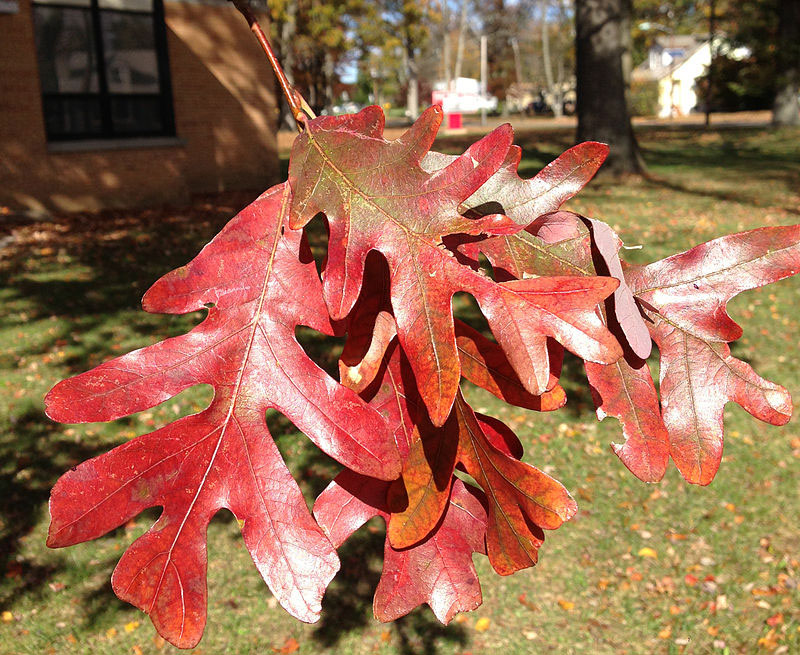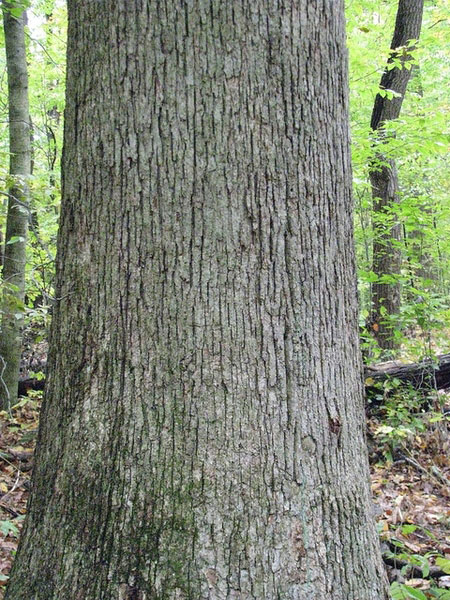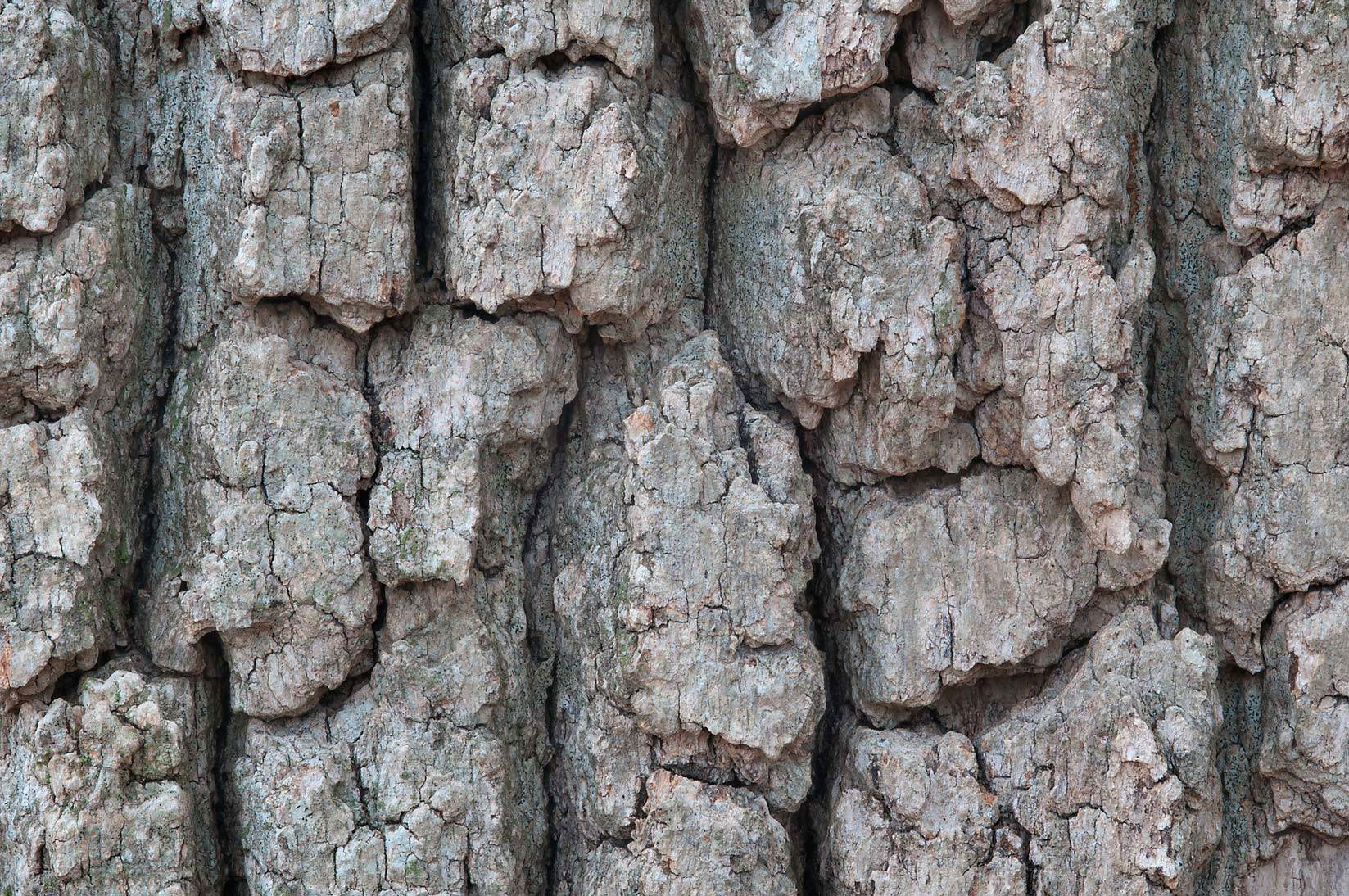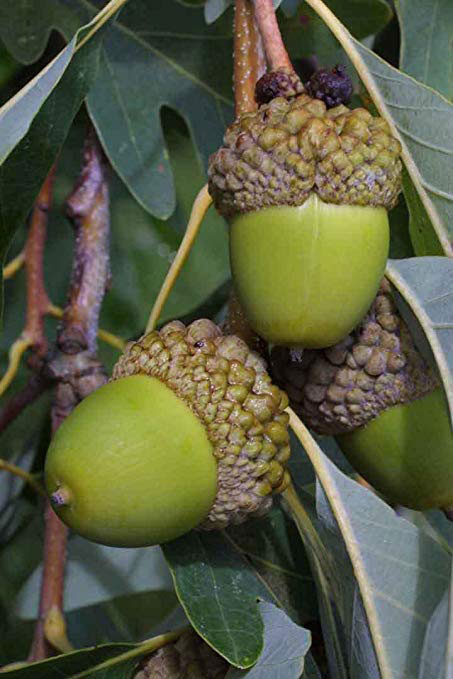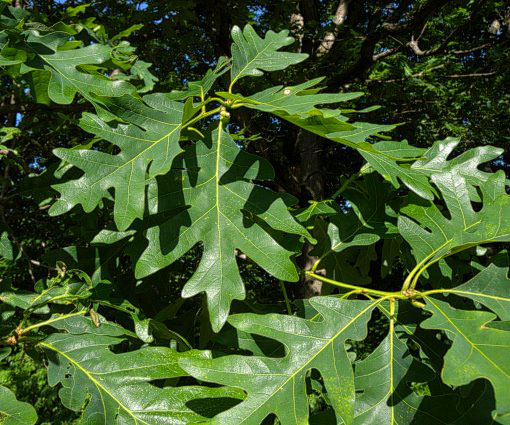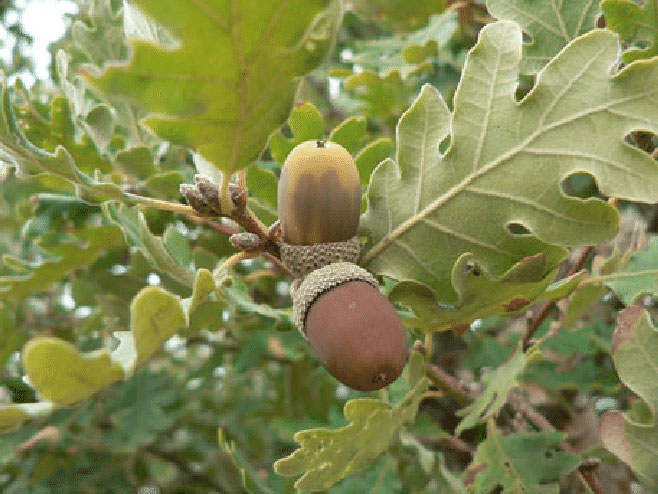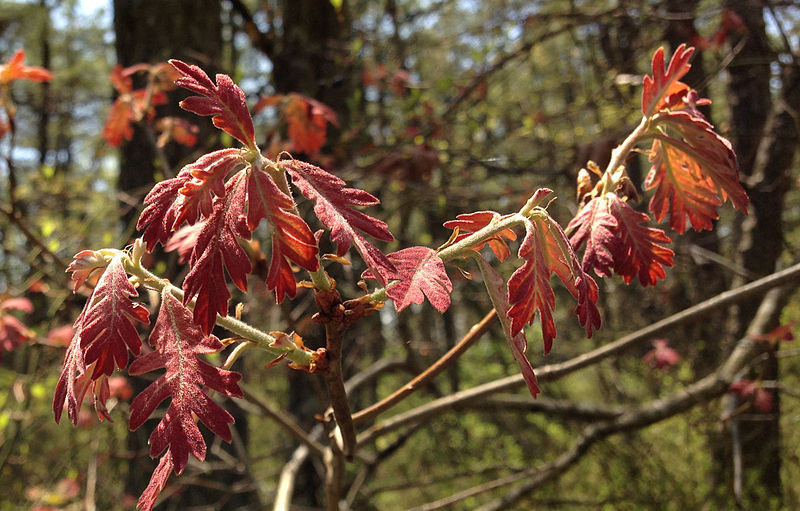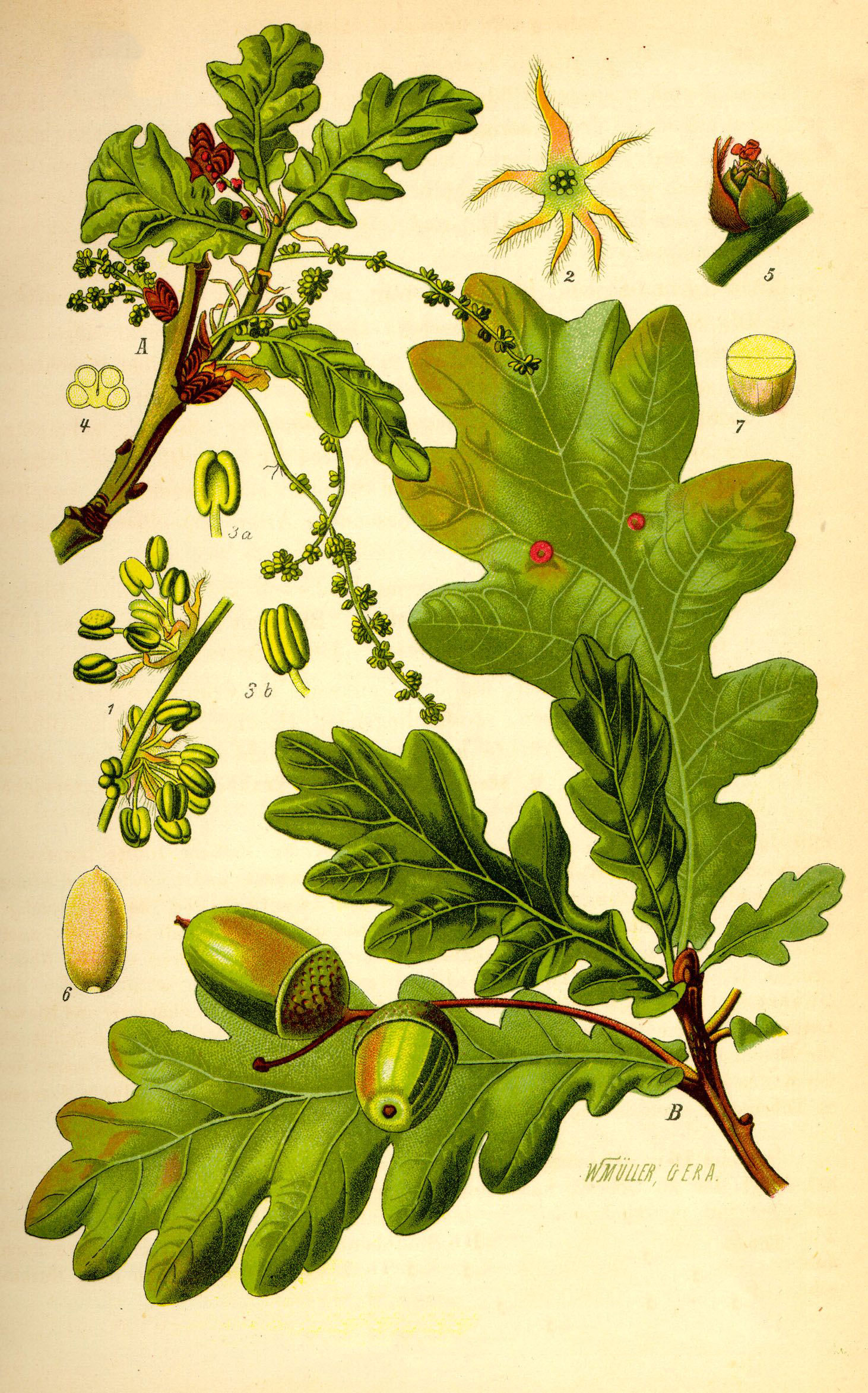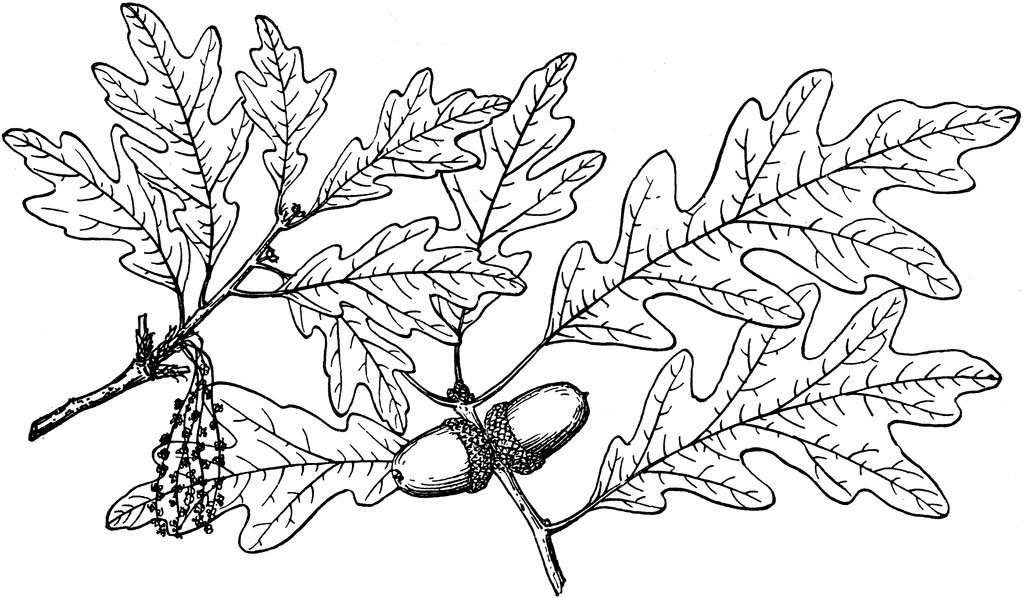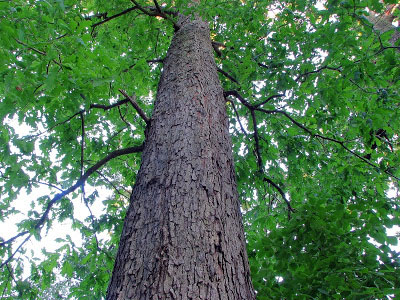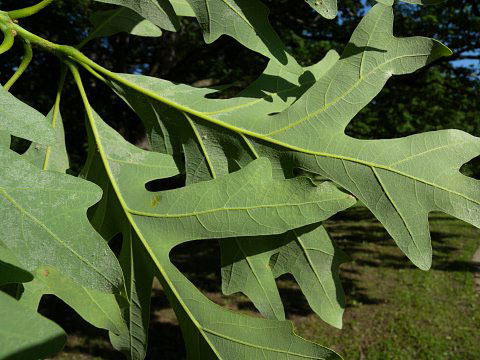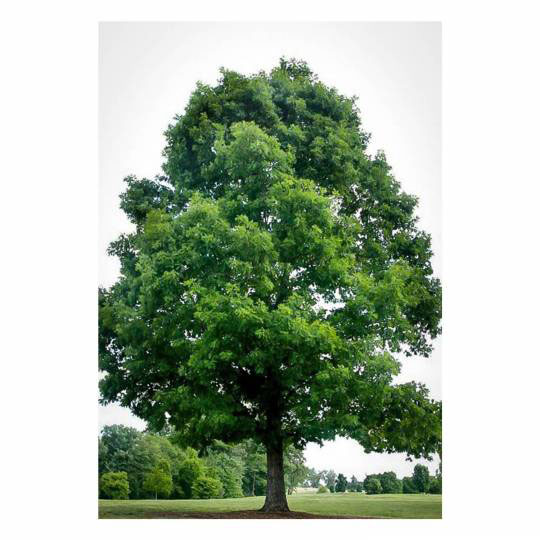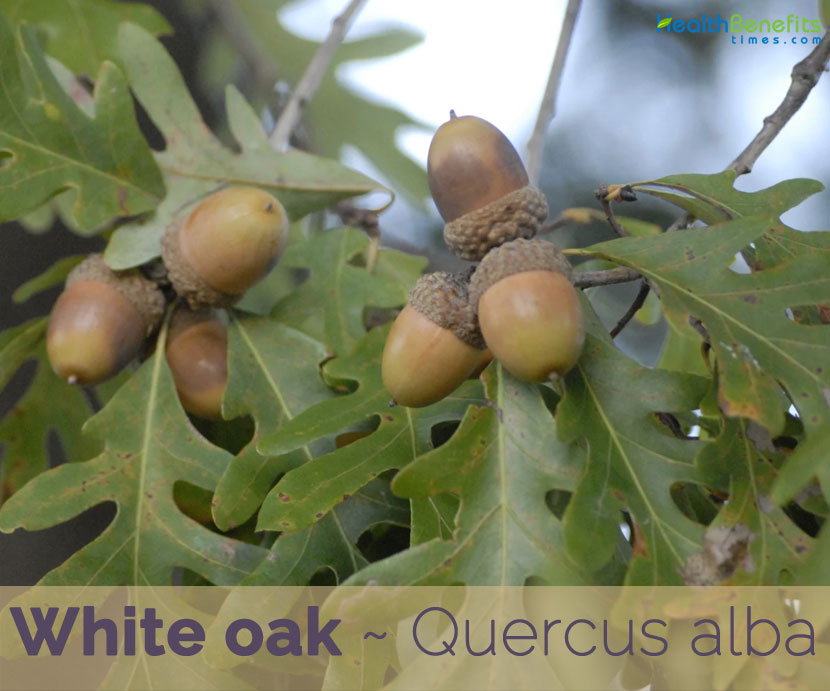 Quercus Alba, commonly called white oak is a large deciduous Missouri native tree belonging to Beech family Fagaceae. The plant is native to eastern and central North America and found from Minnesota, Ontario, Quebec, and southern Maine south as far as northern Florida and eastern Texas. Apart from white oak it is also known as White Oak, Northern White Oak, Eastern White Oak, Stave Oak, Ridge White Oak and Forked-leaf White Oak. White oak is the Illinois State Tree. Genus name comes from the classical Latin name for oak trees. Species name of Alba means white in reference to the light ash-gray bark.
Quercus Alba, commonly called white oak is a large deciduous Missouri native tree belonging to Beech family Fagaceae. The plant is native to eastern and central North America and found from Minnesota, Ontario, Quebec, and southern Maine south as far as northern Florida and eastern Texas. Apart from white oak it is also known as White Oak, Northern White Oak, Eastern White Oak, Stave Oak, Ridge White Oak and Forked-leaf White Oak. White oak is the Illinois State Tree. Genus name comes from the classical Latin name for oak trees. Species name of Alba means white in reference to the light ash-gray bark.
Although called a white oak, it is very unusual to find an individual specimen with white bark; the usual color is a light gray. The name comes from the color of the finished wood. In the forest it can reach a magnificent height and in the open it develops into a massive broad-topped tree with large branches striking out at wide angles.
Plant description
White oak is a medium to large, spreading, slow growing, and long lived, deciduous tree that grows about 60 to 80 feet (18-24 m) in height. On favorable sites, individuals may grow to more than 100 feet (30 m) in height and exceed 5 feet (1.5 m) in diameter. The plant is found growing in dry woods, gravelly ridges, sandy plains, rich uplands, moist bottoms, upland woodlands, well-drained areas of bottomland woodlands, sandy woodlands, bluffs, wooded slopes, savannas and sandy savannas, edges of limestone glades, and high riverbanks above the flood zone. It is found growing on many soil types, white oak does best on coarse, deep, moist, well-drained, with medium fertility, and slightly acid soils. It is well adapted to heavy soils and north and east-facing slopes. Natural stands are often found in areas with loam and clay soil. White oak is moderately resistant to ice breakage, sensitive to flooding, and resistant to salt spray and brief salt-water submergence.
The plant has taproot and widely spreading lateral roots. Bark is whitish or ashy gray, varying from scaly on smaller stems to irregularly platy or blocky on large stems. On older trees smooth patches are not uncommon. Twigs are red-brown to somewhat gray, even a bit purple at times, hairless and often shiny; multiple terminal buds are red-brown, small, rounded (globose) and hairless. Wood is light brown with paler sapwood; strong, tough, heavy, fine-grained and durable.
Leaves
Alternate leaves occur along the twigs and young shoots. New leaves are pubescent, but they become hairless later. Mature leaves are 5 to 8.5 inches (13–22 cm) long and 2.75 to 4.5 inches (7.0–11.4 cm) wide they are broadly elliptic or obovate in outline and pinnatifid with 3-5 pairs of deep to medium lobes. The lobes have round tips and round sinuses; sometimes a few small secondary lobes are present. The upper surface of mature leaves is medium green and glabrous, while the lower surface dull light green or gray-green and hairless (or nearly so). The leaf bases are narrow and wedge-shaped (cuneate). The petioles are ¼-¾ inch long; light green to yellow, and glabrous. Because of the short petioles and their stiff texture, the leaves are resistant to fluttering in the wind. They usually turn red or brown in autumn, but depending on climate, site, and individual tree genetics, some trees are nearly always red, or even purple in autumn. Some brown, dead leaves may remain on the tree throughout winter until very early spring. The lobes can be shallow, extending less than halfway to the midrib, or deep and somewhat branching.
| Leaf Arrangement | Alternate |
| Leaf type | simple |
| Leaf margin | Lobed, parted |
| Leaf Shape | Obovate, Oblong |
| Leaf Venation | Pinnate |
| Leaf Type and Persistence | Deciduous |
| Leaf Blade length | 2 to 8 inches |
| Leaf Color | blue green and shiny on top, paler green to almost white underneath with slight pubescence |
| Fall Color | Red |
| Fall Characteristics | Showy |
Flower
White Oak is monoecious, separate male (staminate) and female (pistillate) flowers are produced on the same tree. Male flowers are produced in greenish yellow catkins about 2-3½ inches long that develop near the tips of last year’s branches. Individual male flowers are 1/8 inches (3 mm.) across or less, consisting of an irregularly lobed calyx and several stamens. Greenish red female flowers are produced at the tips of new shoots on very short peduncles (less than 1/8 inches or 3 mm. long). Individual female flowers are 1/8 inches (3 mm.) across or less, consisting of a pubescent calyx that surrounds an ovoid ovary with 3 stigmata. The blooming period occurs from mid- to late spring for about 1-2 weeks. The flowers are cross-pollinated by the wind.
| Flower color | male – yellow-green
female – reddish-green |
| Flower characteristics | not showy;
Male – 2 to 4 inch long catkins; Female – spike that emerges from leaf axils |
| Flowering | mid spring, with the leaves |
Fruit/ Acorns
Fertile female flowers are replaced by acorns that become mature by the fall. Mature acorns are ½-1 inches long, consisting of a shallow cap and a nut. The cap is light tan or light gray with warty scales; it extends downward to about one-fourth the length of the acorn. The nut exterior is greenish brown to light brown, ovoid in shape, and glabrous, while the meat of the nut is white and usually slightly bitter.
| Fruit Shape | Oval |
| Fruit Length | ½ inch |
| Fruit Covering | dry or hard pubescent acorn; cap is bowl-shaped, thin, flattened, slightly pubescent, and covers 1/3 to 1/2 of the nut |
| Fruit Color | orange-brown |
| Fruit Characteristics | attracts squirrels/mammals; not showy; fruit/leaves a litter problem |
| Fruiting | Early fall |
Health benefits of White Oak
Listed below are some of the popular health benefits of White Oak
1. Respiratory Health
White oak bark can help to treat infections of the respiratory tract. Its saponin content means that it might have expectorant properties suitable for getting rid of mucus and phlegm from the respiratory system. Tea made from the herb is often used to treat coughs, colds, bronchitis and other respiratory conditions.
2. Promotes Shinier Hair
If you suffer from dry, dull hair, you know how frustrating it can be especially in terms of breakage. On a daily basis, your hair is exposed to a number of stressors. In order to remain healthy, it needs to be cared for. By providing your hair with this level of support you can ensure that your hair is as shiny and healthy as possible.
White oak bark is also often recommended when aiming to take the coarseness out of hair. This is mainly true for graying or silver hair. That is why for optimal hair health, be sure to include a hair serum into your daily routine.
3. Oral Health
In the days before dentistry, the Native Americans used white oak bark to help treat oral infections and other dental issues like gingivitis and toothache.
Bark consists of antibacterial and antiseptic properties which can help prevent and treat oral infections as well as being an astringent that will help oral sores to heal. You can make a natural mouthwash by boiling up a cup of white oak bark tea and allowing it to cool.
4. Visibly improves a flaky scalp
White oak bark is known to offer soothing properties, potentially benefiting those suffering from a dry, flaky scalp. When applied topically, it can help target problematic skin including the skin found on your scalp. Often studied because of its potential impact on eczema and other dermal problems, white oak bark may help reduce inflammatory symptoms of the scalp.
In terms of a potential infection, white oak bark’s tannin influences its antiseptic property. This means that it may help actively prevent and fight the build-up of bacteria. Medical professionals often recommend white oak bark for various conditions based on this beneficial effect.
Traditional uses and benefits of White oak
- White oak was often used medicinally by several native North American Indian tribes, who valued it especially for its antiseptic and astringent properties and used it in the treatment of many complaints.
- Inner bark consists of powerful antiseptic and astringent properties and is also expectorant and tonic.
- Bark is boiled and the liquid drunk in the treatment of bleeding piles and diarrhea, intermittent fevers, coughs and colds, consumption, asthma, lost voice etc.
- Bark has been chewed as a treatment for mouth sores.
- Externally, it is used as a wash for skin eruptions, burns, rashes, bruises, ulcers etc. and as a vaginal douche.
- It has also been used as a wash for muscular pains.
- Bark is best collected in the spring.
- Any galls produced on the tree are strongly astringent and can be used in the treatment of hemorrhages, chronic diarrhea, dysentery etc.
- It reduces the risk of bacterial and viral infections.
- It aids the ability of the body to fight against infections.
- It reduces the risk of infectious diseases such as sexually transmitted diseases and other disorders.
- It is used externally to get rid of skin disorders and insects bites.
- Its antiseptic factors are beneficial to treat skin rashes, bruises and vaginal discharge.
- It is used as an ointment to treat eczema, burns and cuts.
- The herb is also used to treat oral issues like toothache and gingivitis.
- Gargles are beneficial for bleeding gums and mouth ulcers.
- Anti-inflammatory factor reduces the inflammation associated with Cough and Bronchitis.
- Viral infections may cause damage to the Lungs.
- It fights for infections and protects the lungs from damage.
- Extract is used to reduce the phlegm and treats Cold.
- It is effective for asthma and throat Infections.
- It is helpful to prevent the development of initial symptoms of Chilblains.
- It helps to stop the internal and external bleeding.
- It contracts the body tissues and restores their elasticity.
- White Oak is good herbal for treatment for diarrhea and hemorrhoids.
- This is used to treat Nose bleeding and vomiting.
- It regulates the menstrual cycle. It eases the flow of blood in difficult Menses.
- It is helpful in varicose veins also.
- It reduces the itching associated with genital problems.
- This helps to regulate the kidney and bladder functions.
- It reduces the risk of bladder infections and flushes out the kidney stones.
- It prompts the urination and clears the passages.
- Oils obtained from pressed acorns were used to alleviate pain in the joints.
- It can also be applied topically in the form of a bath or compress to treat poison ivy rashes, bites, burns and minor wounds.
- Piles can be treated by this herb. An equal amount of White oak bark and lobelia seeds should be powdered and applied as an ointment on the bleeding piles which is painful condition.
- Decoction of White oak bark is used to relieve pain and bruises.
- It treats effectively passive hemorrhages of lungs, uterus, bowels, especially after typhus.
- Its bath is quite effective in strengthening skin and also tones flaccid structures of children and adults.
- Powder of White oak bark if applied continuously on scalp prevents hair loss and dandruff.
- This herb lowers temperature in fever, decreases dryness and weakness due to fever.
- It relieves bronchitis and associated symptoms like difficulty in breathing, chest pain, lassitude etc.
- It is also used to treat signs and symptoms of inflammation like pain and swelling of skin, throat, mouth genitals and anal region.
Ayurvedic Health benefits of White oak
- Cold Sores: Use White Oak Bark paste on the Cold Sores. It helps in contracting the tissues and as a result Swelling is reduced.
- Ganglion: Apply White Oak Bark paste, made of White Oak Bark powder and lukewarm water over the affected area. Leave it for 30 minutes.
How to make White Oak Bark Tincture
As long as you have access tom the tree, it is not hard to make your own white bark tincture. These are the steps to follow:
You will need white oak tree twigs, some pruners, a vegetable peeler, a mason jar and some vodka,
- Gather up plenty of white oak tree twigs. (using the bark from the twigs is less likely to damage the tree than using the bark from the trunk)
- Clean any dirt or debris from the twigs.
- Peel the bark from the twigs with your vegetable peeler.
- Put the bark into a mason jar then cover the twigs with your vodka.
- Cover and tore the jar in a dark, cool place and let the mixture sit for at least a few weeks but preferably a month before using it.
- When the extract is ready, strain the mixture into a bowl using a strainer lined with muslin or some other cotton material.
- Make sure that you squeeze down on the remaining bark with a spoon to extract all the goodness from the bark.
Other Facts
- White oak is potentially valuable for use in reforestation projects, and appears to have potential for use on other types of disturbed sites.
- It has been planted on strip-mined lands in Ohio, Indiana, and Illinois, and has exhibited good growth and survival on cast overburden and graded topsoil overlying mine spoils.
- Leaves of most species in this genus are more or less rich in tannins.
- Mulch of the leaves can be placed around vulnerable plants in order to repel slugs, snails, grubs etc.
- Fresh leaves should be used with caution, since these can utilize some of the nitrogen in the soil and this inhibit plant growth.
- Brown dye is obtained from the bark or from the galls; it does not require a mordant.
- Yellow, chrome and gold can also be obtained if mordants are used.
- Wood is strong, very heavy, hard, tough, strong, close grained, durable and is used for cabinet making, furniture, paneling, flooring, construction, mine props, agricultural tools etc.
- It is highly valued for making the staves of barrels for storing wine and liquor.
- Wood is a good fuel giving off a lot of heat.
- The tallest known white oak is 144 feet (44 m) tall.
- It is the symbolic state tree for both Illinois and Maryland.
Precautions
- Side effects of an overdose include kidney or liver damage, nausea, and other stomach problems.
- Pregnant women and nursing mothers should play it safe and avoid using white oak bark supplements.
- It is also not recommended for people with preexisting kidney or liver disease.
- Children should not use white oak bark supplements.
- People with certain skin conditions including eczema or skin damage to large areas of their skin should avoid white oak bark baths.
- Patients with cardiovascular diseases should not take White oak bark or its any medicinal preparations.
- In the case of Hypertonia, i.e. a nerve condition affecting muscles and causing over the tightness of muscles, White oak bark should not be used.
- White oak bark may make kidney ailments worse, so it should be avoided in any of the kidney disease patients.
- Liver problems may worsen by taking white oak bark.
References:
https://www.itis.gov/servlet/SingleRpt/SingleRpt?search_topic=TSN&search_value=19290#null
https://pfaf.org/user/Plant.aspx?LatinName=Quercus+alba
https://www.missouribotanicalgarden.org/PlantFinder/PlantFinderDetails.aspx?kempercode=l930
https://plants.usda.gov/core/profile?symbol=qual
https://plants.usda.gov/factsheet/pdf/fs_qual.pdf
https://www.fs.fed.us/database/feis/plants/tree/quealb/all.html
https://www.wildflower.org/plants/result.php?id_plant=QUAL
https://davesgarden.com/guides/pf/go/66279/#b
http://hort.ufl.edu/trees/QUEALBA.pdf
https://www.bates.edu/canopy/species/white-oak/
https://plants.ces.ncsu.edu/plants/quercus-alba/
https://en.wikipedia.org/wiki/Quercus_alba
http://www.theplantlist.org/tpl1.1/record/kew-171499
https://www.fs.fed.us/database/feis/plants/tree/quealb/all.html
https://gd.eppo.int/taxon/QUEAL
https://www.illinoiswildflowers.info/trees/plants/white_oak.html
http://dendro.cnre.vt.edu/dendrology/syllabus/factsheet.cfm?ID=35
https://www.cabi.org/isc/datasheet/46376
https://npgsweb.ars-grin.gov/gringlobal/taxonomydetail.aspx?316805


